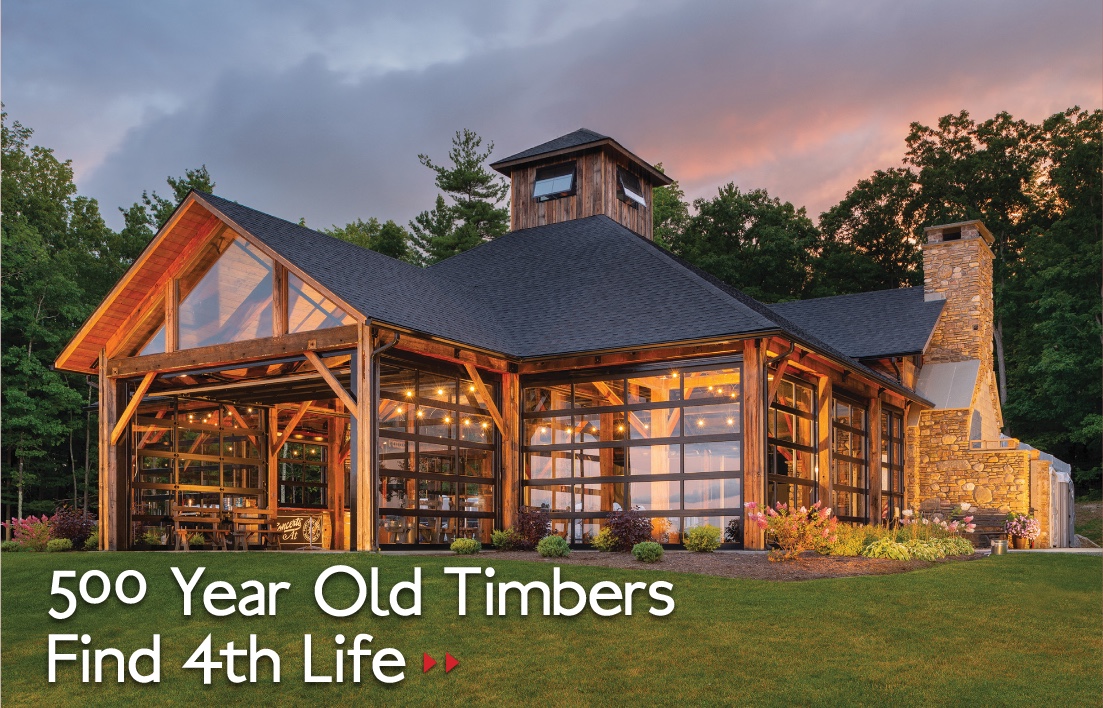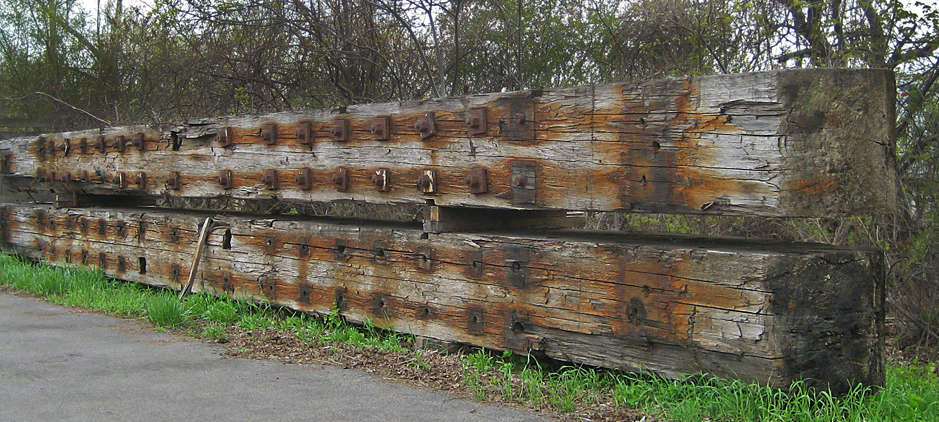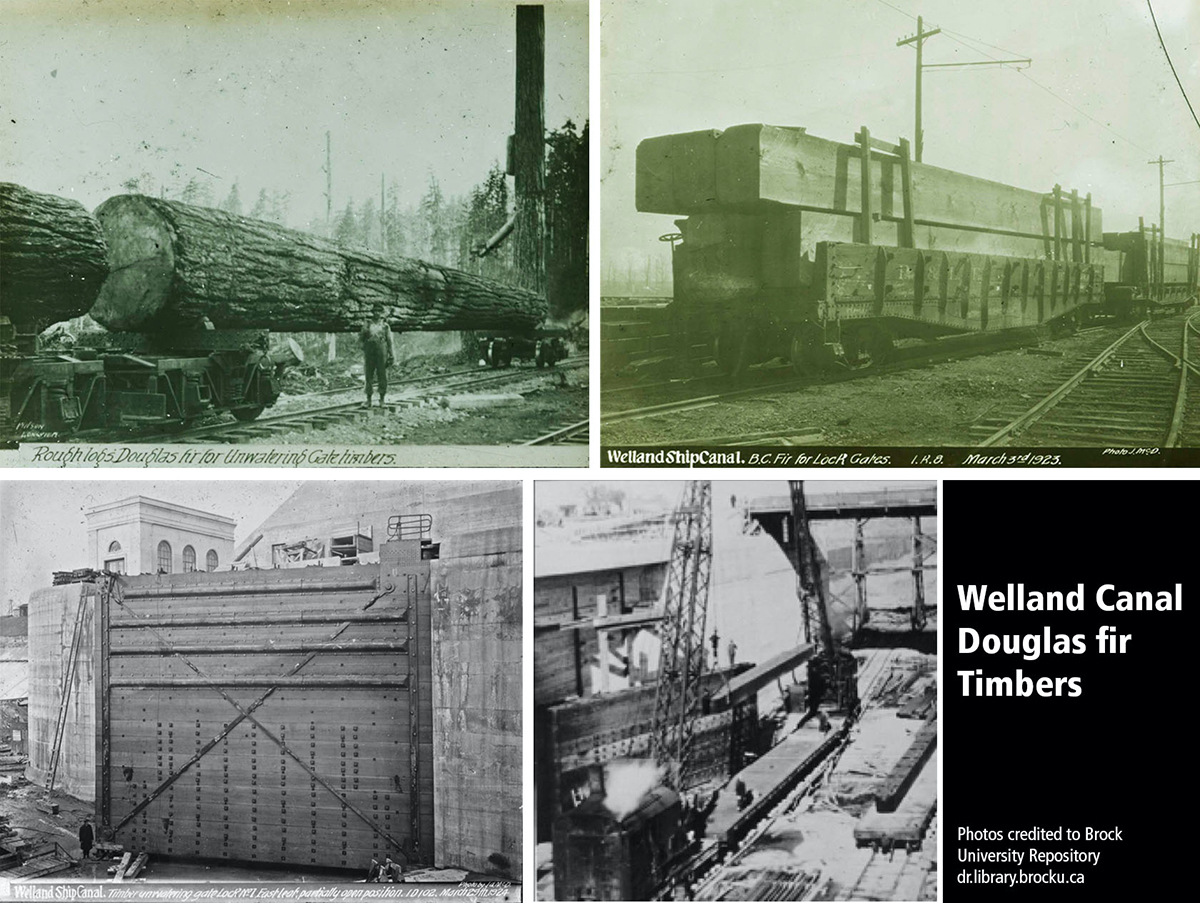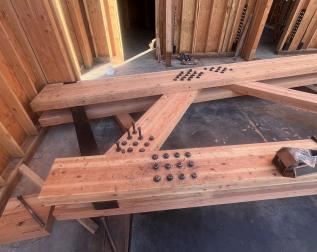From tree to canal lock to restaurant: In a historic timber reclamation and upcycling story, 500-year-old timbers enter their fourth life (or third use) at Point of the Bluff Vineyards in the Finger Lakes Region of NY:

In the late 90’s our sister company, Pioneer Millworks, salvaged massive, 37″ x 42″ x 48′ Douglas fir timbers from one of the Welland Canal locks in Ontario, Canada. The trees culled for the timbers were 400+ years old when they were harvested and served the canal for nearly 60 years.
From the beginning–a bit history of on the heavy timbers:

37″ x 42″ x 48′ Douglas fir timbers from the Welland Canal Lock. The trees were at least 400 years old when they were harvested in the early 1900’s.
The falls and rapids of the Niagara River presented a major obstacle for an uninterrupted waterway from the Atlantic Ocean to the American heartland. To circumvent the river, the Welland Canal, with eight large locks, was built. Initiated by local businessmen, the first canal was built in 1829. The present-day Welland Canal is the fourth to be constructed. The difference of 99.5 m (326.5 feet) between the levels of Lake Ontario and Lake Erie is now overcome with 43.4 km (27 miles) of canal.

During renovations of the third canal in 1927, Douglas fir timbers were installed in Lock N0. 8, one of the longest canal locks in the world. As the canal locks were updated/repaired, the wood was removed in the late 1990s and the enormous timbers, each weighing over 20,000 lbs, headed to Pioneer Millworks Farmington, NY yard.

Pioneer Millworks de-nailing team set about removing the metal artifacts from the old canal timbers which required heavy equipment.

An Alaskan Mill, or PortaMill, with two operators was required to slice the large timbers.
We marveled at the size, texture, and tones in the (then) waterlogged timbers. We had the right-fit client looking to build a timber-frame-with-a-story restaurant at Steamboat Landing on Canandaigua Lake. The canal timbers were resawn, revealing some unique mineral staining and tight grain as they headed to our timber frame shop.
It is a pleasure and a challenge to work with reclaimed timbers. Our team takes special consideration of the orientation of each timber, fresh or reclaimed, for every project. In the case of Steamboat Landing’s Cove Restaurant, the character of the timbers was intentionally exposed to showcase and celebrate the history of the wood.

The reclaimed canal timbers, crafted into parallel chord trusses, posts, braces, and beams, were oriented to showcase their previous life with large bolt holes, grooves, and mineral staining easily visible in all areas of the frame.
Nearly 20 years ago our team raised the hand-crafted frame for the Cove Restaurant.

Steamboat Landing’s Cove Restaurant as seen from Canandaigua Lake.

Inside the Cove Restaurant, the reclaimed timber’s patina and mineral staining were celebrated throughout each space.
In 2015 the restaurant was slated for demolition, doomed by incoming development. Our craftsmen, many of whom had worked on the Cove Restaurant frame decades-back, set about carefully dismantling the joinery and removing the timbers once again.

It is a testament to the durability of wood and build quality of timber framing as a construction method that this demolition/salvage was even possible.
Point of the Bluff Vineyards was interested in giving the old timbers their fourth life. They worked with our design team, detailing their vision of an event and tasting space situated at the top of their vineyards with open views of Keuka Lake. The design pays homage to the original frame layout, maintaining a major symbolic element: the cupola.

The reclaimed frame was modified for its new role at Point of the Bluff, but the design maintained the original cupola.

To see the timbers continue to have a purpose, now with Point of the Bluff Vineyards, is a best-case scenario. Photo by Don Cochran Photography.


Other timbers from the Welland Canal salvage have been repurposed into other frames, fine furniture, flooring, and more.

A Rochester, NY restaurant made space for two heavy 6″x32″x10′ slabs crafted from the Welland Timbers by our fine woodworking division, NEWwoodworks. The resulting community-style tables have fresh sawn tops showing the Douglas fir’s mineral staining and tight grain with original as-found timber edges.

MUJI in Portland, Oregon created a central display with the end of one of the Welland Canal timbers, keeping some of the metal intact within the wood.
There is a single “chunk” of the Welland Canal timbers remaining. While we’re a bit sad to see the last of these once-in-a-lifetime timbers, our sister company has many other agricultural, as-found, and industrial salvaged timbers with remarkable histories, textures, and tones that continue to fulfill our timber frame dreams. Like these long and large Douglas fir timbers reclaimed in Portland OR, now situated in Pioneer Millworks McMinnville, OR yard that top out at 22″x38″x52′:

And large logs from the Willamette River in Oregon that are teeming with sculptural texture:

Reclaimed timbers are special, bringing history, character, rich patinas, and tight grain to each use. We’re always glad to talk about the built environment, particularly where timber framing and high efficiency is concerned. If you’d like to chat, reach out to us today.














